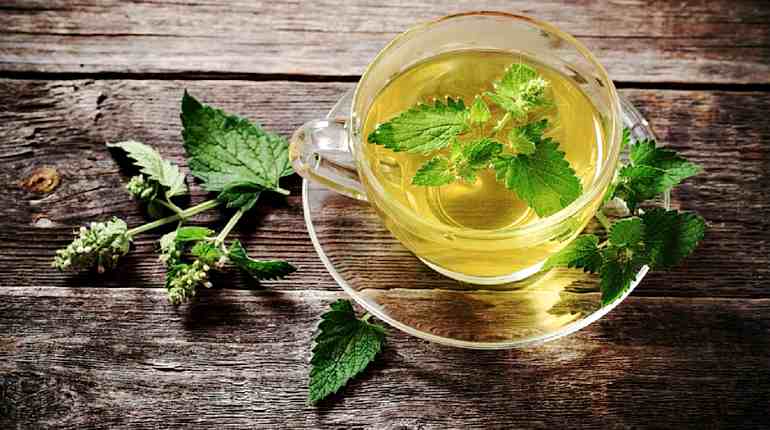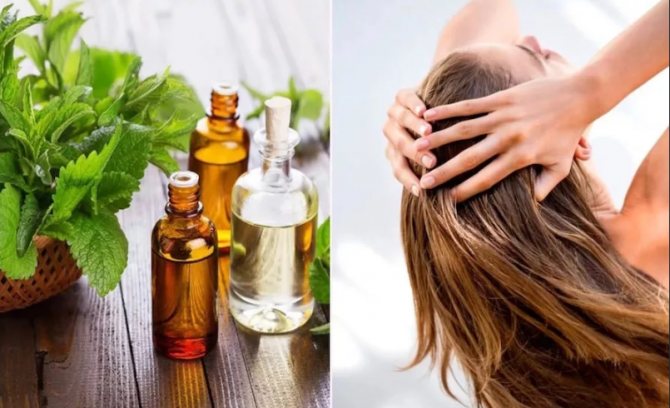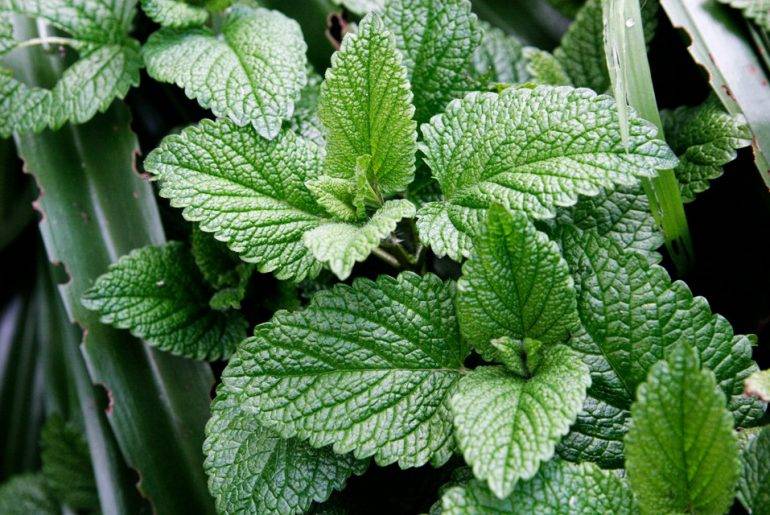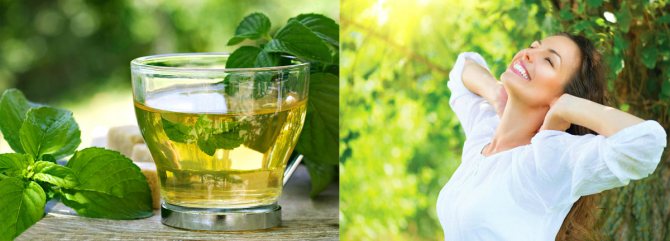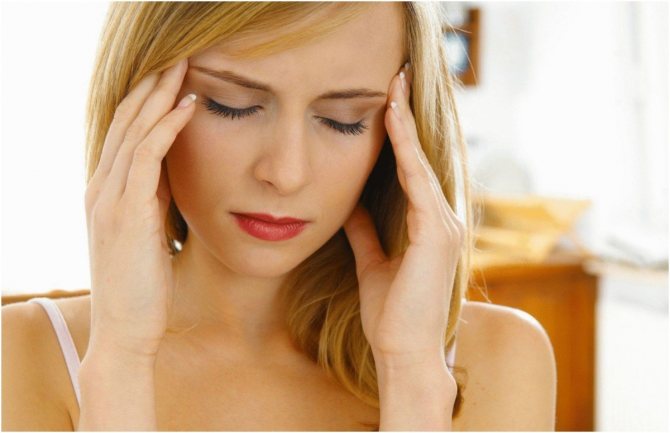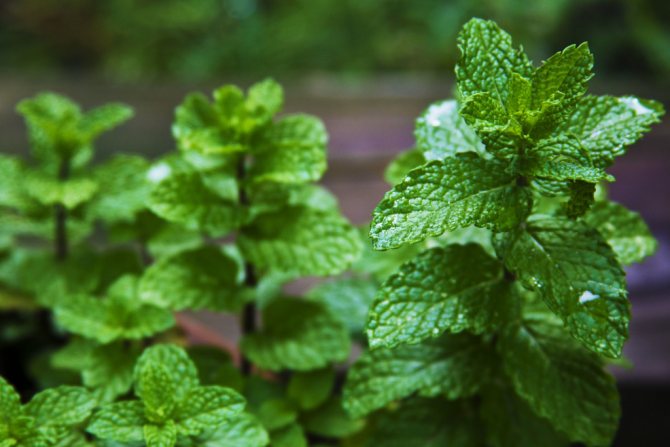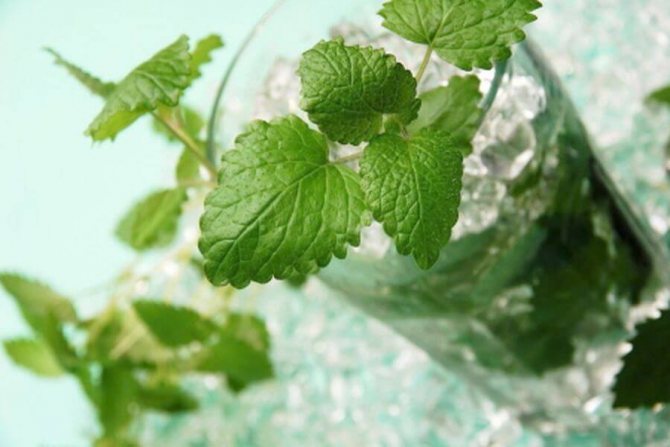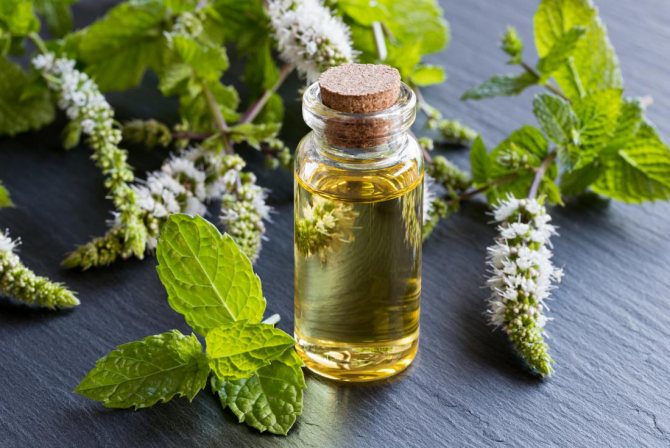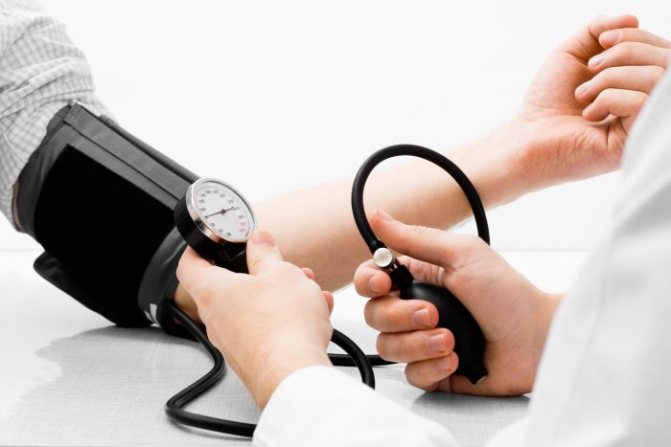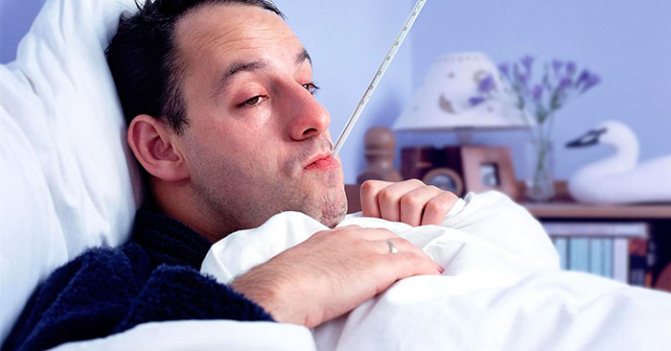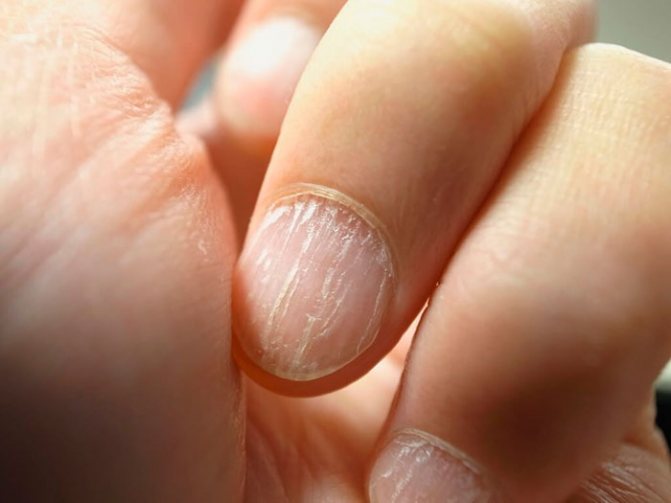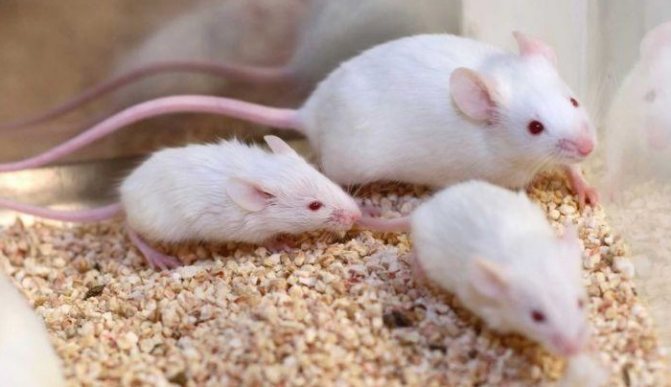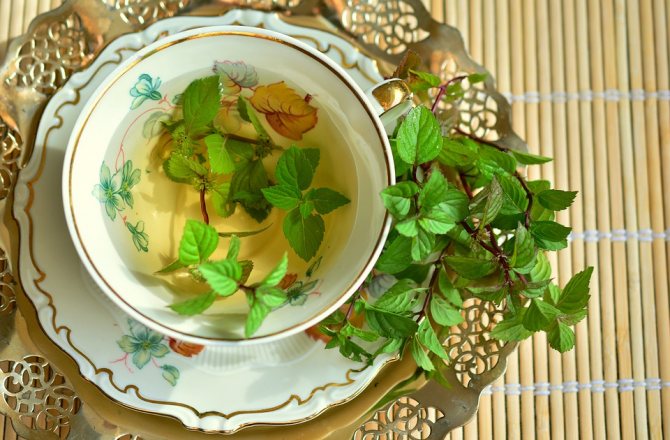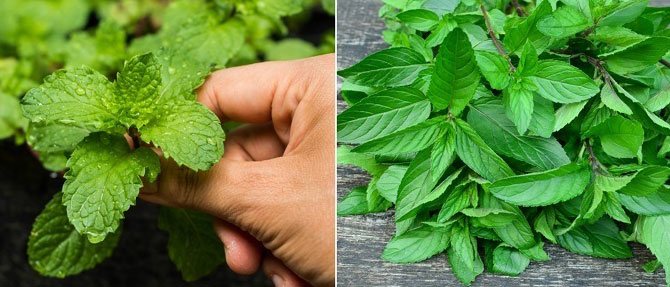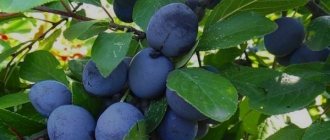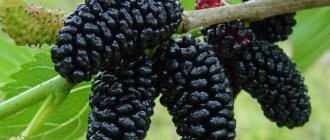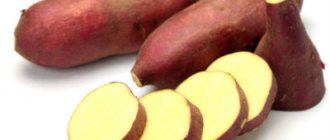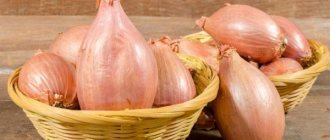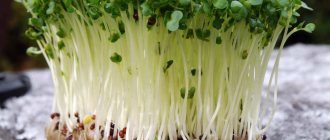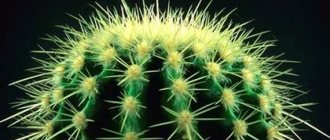Mint is an essential component of aromatic rustic tea. It is grown in the garden and, if possible, harvested in the wild. The mint that people used to consider cultural - peppermint - is actually a hybrid of two wild sisters - water mint and spearmint. Therefore, you can use all three types with similar properties. The rest of the mint varieties, of which there are many, vary greatly in the composition of essential oils, which is reflected in the different aroma of the leaves.
The etymology of the plant's name is legendary. It is believed that it came from the name of the nymph Menta, who, having tempted the riches of the ruler of the kingdom of the dead, Hades, desired to enter into an affair with him. However, his wife Persephone found out about this, and, blinded by jealousy, betrayed her rival to death. At the place of her death, a fragrant bush grew, called the cop, or mint.
Mint is mentioned in many sections of history. She is mentioned in the Gospel of Matthew, her twigs were among the incense in Egyptian tombs, in ancient Rome it was customary to wear plant wreaths for the flexibility of the mind, Hippocrates whitened her teeth with infusion and believed that she caused male impotence, and Alexander the Great, on the contrary, imposed a ban on the use of mint during hiking, as he considered it an aphrodisiac. Such contradictory properties of the same plant prompt us to figure out what mint is: its benefits and harms for humans are largely determined by its composition.
What are the types and varieties of mint
- australian mint,
- pineapple mint,
- pennyroyal,
- water mint,
- daurian mint,
- long-leaved mint,
- fragrant mint
- ginger mint,
- canadian mint,
- spearmint,
- small-flowered mint,
- peppermint,
- field mint,
- apple mint,
- Japanese mint,
- and etc.
Peppermint, field mint and fragrant mint are most often found in our country.
Chemical composition of mint
Vitamins: A, C, D, B1, B2, B5, B6, B9, PP.
Minerals: iron, potassium, calcium, magnesium, manganese, copper, sodium, zinc, phosphorus.
Acids: valeric, linoleic, mellicic, oleanolic, acetic, ursolic.
Peppermint is especially prized for its essential oil content (2.5-4.5%), which consists of menthol and its esters. Interestingly, the leaves contain only 0.5% menthol, while the stem of the plant contains 40%.
Calorie content of mint - 50-70 kcal per 100 g.
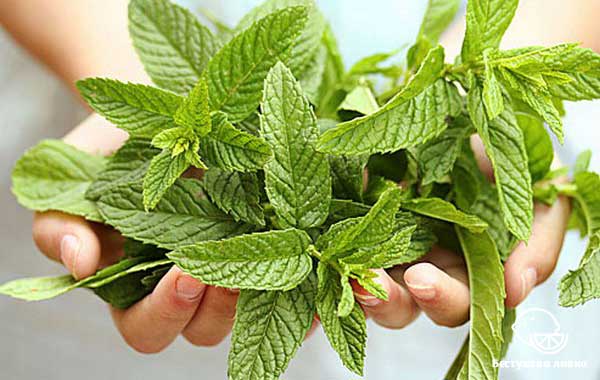
Benefits and health benefits of peppermint
- has analgesic and diuretic properties,
- helps with flu,
- prevention and treatment of colds,
- relaxes the abdominal muscles,
- improves digestion,
- treats stomach diseases,
- relieves flatulence,
- helps with diarrhea,
- promotes weight loss,
- stops putrefactive processes in the intestines,
- eliminates the feeling of nausea,
- treats diseases of the respiratory system,
- fights tuberculosis, asthma and bronchitis,
- slows down the heartbeat,
- helps with hypertension,
- eliminates headaches,
- relaxes the nervous system,
- relieves irritation and fatigue,
- helps to fall asleep,
- strengthens vision,
- refreshes the oral cavity,
- heals wounds and bruises,
- reduces the growth of unwanted hairs,
- heals skin diseases,
- relieves itching,
- improves the condition of the skin and hair.
Properties and uses of peppermint essential oil
Peppermint oil is one of the popular essential oils.It fell in love due to its aroma, in which pleasant notes of chill are caught.
The mint scent is considered to be feminine, it symbolizes her charm, courage, desire for adventures. The energy of mint is capable of completely renewing and restoring a person's strength. That is why oil is often used to improve the functioning of the nervous system. It gives self-confidence, relieves irritability, relieves anxiety, strengthens the heart. In addition, it is recommended to carry peppermint oil with you if you are seasick in transport.
In cosmetology, it is used to treat skin diseases, diseases of the oral cavity and improve the condition of the hair.


Mint tea is good for your health
Mint tea is drunk for calming and for spiritual harmony. In addition, the aromatic drink eliminates indigestion, increases appetite, and perfectly tones up in the heat. It is used medicinally to reduce coughs and fever.
Mint Tea Recipe
It is prepared very simply. You need fresh mint leaves or 1 tbsp. brew dry raw materials with 1 glass of boiling water. The broth will be ready in 10-15 minutes. Optionally, add a lemon wedge and a cinnamon stick.
Can you drink mint during pregnancy?
Pregnancy is an unpredictable period, so there are still many opinions about the use of mint while waiting for a baby. In general, mint solutions are not contraindicated and will be very useful, but in limited quantities. It is recommended to drink them once a day 3-4 times a week.
During pregnancy, the herb helps with nausea, relieves colic, itching and relaxes the nervous system. In addition, mint leaf tea is very good at relieving constipation, which is common in women during this period.
Contraindication and harm
- individual intolerance,
- infertility,
- breast-feeding,
- children under 3 years old,
- low pressure,
- varicose veins.
Excessive consumption of peppermint leads to heartburn and decreased male libido.
How does mint affect men? Impact on potency
The negative effect of peppermint on male potency is a very common misconception. A negative result is achieved only under the condition of prolonged brewing of the leaves (at least 5 minutes) and drinking a large amount of mint broth (2-3 times a day). If a man drinks only 1 cup of weakly brewed herbal tea, and even very rarely, then there is no reason for concern.
True, there is information that this plant slows down the activity of sperm, but this does not apply to potency itself.
When to collect
The entire summer period is considered to be the mint harvest time. If you want to pluck the leaves for making fresh tea, then this can be done in the spring when the first sprouts appear. But if you need grass to prepare raw materials for the winter, then you should wait until mid-June. July is the peak of the harvest season. At this time, the mint had already grown and gained the maximum of its aroma. Leaves should be cut 1-3 times a month.
How to properly dry mint at home
1 way. Cut off the stems of the grass along with the leaves and flowers. Rinse the lower part with clean water, wait until it drains. Then spread the mint on a clean cloth somewhere in the shade out of the sun.
The content of nutrients in mint


Since the composition of the active substances varies slightly from variety to variety, it makes sense to look inside the most common plant variety in cooking and herbal medicine - peppermint. The leaves of the plant contain up to 2.75% of essential oil, in the flowers it is much more - up to 6%. In addition to it, tannins and resins, flavonoids, including hesperidin and rutin, organically acids (caffeic, chlorogenic, ursolic, oleanolic), phytosterols, rhamnose monosaccharide, glucose and saponins are present.Peppermint essential oil is rich in menthol, carvacrol, terpinene, limonene, geraniol, citral and other substances that cause its analgesic and tonic effect. The vitamin composition is represented by vitamins A (203 μg), C (13 mg), PP (0.9 mg) and group B (B1 - 78 μg, B2 - 175 μg, B5 - 250 μg, B6 - 158 μg and B9 - 105 μg). As can be seen from the composition, the healing properties of mint can be talked about at length and at length, but still they come down to the main areas of application.
Composition and characteristics
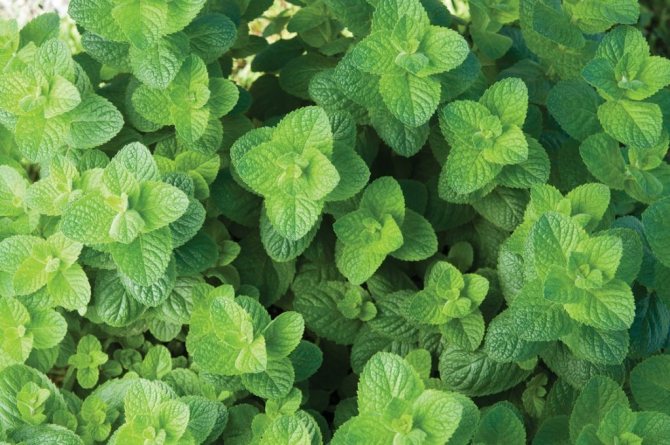

The herb with a unique fresh aroma has a disinfecting and relaxing effect. This is due to the content of tannins, manganese, copper, magnesium and vitamin A. It is used to increase appetite, relieve stress, get rid of depression, as well as to normalize the digestive tract and relieve frostbite and wounds. The usefulness of the herb is explained by the presence of valuable components in the composition:
- vitamins of groups D, C, B and A,
- essential oils (ethers + menthol),
- a whole complex of minerals,
- phytoncides,
- organic acids (acetic, linoleic, valeric),
- phytosterols;
- carotene,
- betaine.
The effect of mint on males


The presence in the composition of mint of a huge amount of substances that affect the human body, no one dares to deny. But it's not that simple! No, of course, the fact that mint is useful for the fair sex is beyond doubt. It has a beneficial effect on the menstrual cycle, tones and refreshes the skin, and helps to strengthen the nervous system. But what about the stronger sex? What benefits does the use of mint bring to the male body, and what threat does it hide? Is it true that the use of this fragrant plant in the diet can lead to male impotence? Unfortunately, today among scientists and healers around the world there is no single opinion on this issue. One thing is certain - the effect of this fragrant herb on the stronger sex should be considered in a separate order.
Useful properties and applications
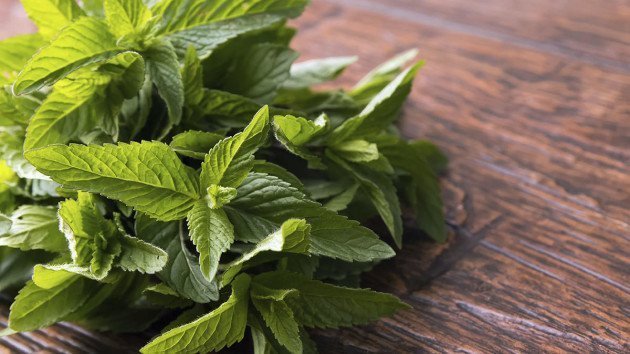

Thanks to the content of vitamins, minerals, menthol and other valuable substances, the plant promotes health and general well-being. Of the positive effects with regular use, the following are noted:
- strengthening the nervous system;
- relieving pain and spasms;
- normalization of the heart, increasing the elasticity of blood vessels;
- increasing intellectual activity;
- improving digestion;
- acceleration of metabolism.
The herb is useful for the fair sex, as it reduces menstrual pain, normalizes hormonal levels, relieves discomfort during menopause, relieves excruciating nausea during pregnancy. The positive effect on a man's body consists in relieving stress, increasing stamina and tone, increasing potency.
In cooking
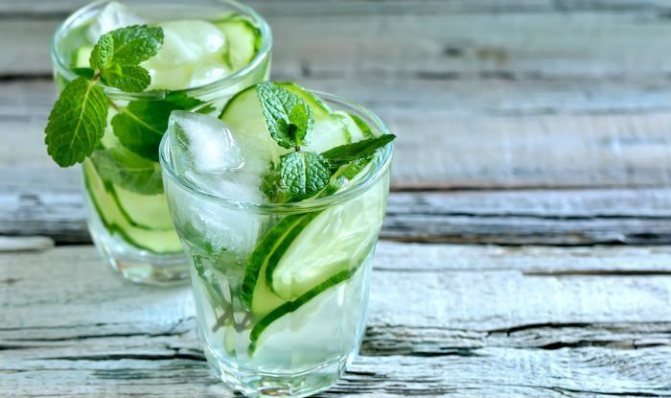

Due to its unique taste and rich composition, the product is widely used in the culinary arts of many nations of the world. With aromatic grass, unusually tasty drinks, desserts, snacks, main courses and sauces are obtained. The leaves of the plant are added to ice cream, baked goods, cakes, cocktails and mousses. For culinary purposes, peppermint, chocolate, curly, and apple mint are used. These varieties have a pleasant taste and no bitterness when heated. Fresh leaves are also good for decorating various dishes.
Dried mint is most often used as an ingredient in decoctions, infusions and teas. Crushed mint powder is an excellent seasoning for fish and meat. It is best to add the herb 5 or 10 minutes before the meal is done. The optimal dosage is half a teaspoon of dry product and no more than 5 g of fresh.
Mint teas are popular, which help to get rid of many health problems, as well as tinctures sold at any pharmacy.By mixing such a product with motherwort or peony tincture, you can achieve a stronger effect from the intake. Mint jam is distinguished by its incredible taste and benefits, which can be used for baking, desserts or eaten with tea. The shredded herb is boiled with sugar, apple cider vinegar and water, after which liquid pectin is added to the mixture. Many housewives additionally use food coloring to get a richer green color of the product.
In folk medicine
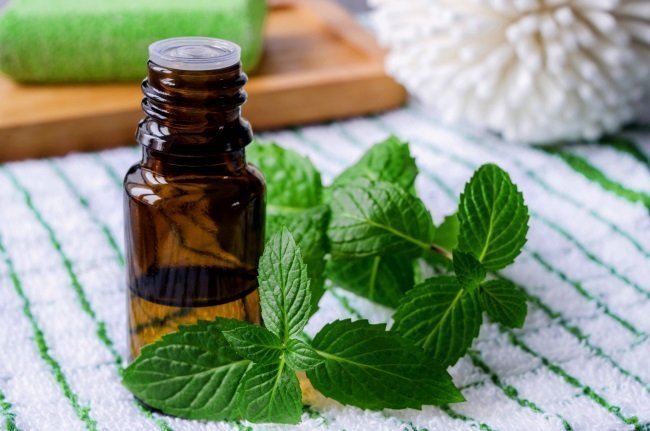

A medicinal herb with a fresh scent and taste helps relieve insomnia, drowsiness, irritability and depression. If you mix herbal tea with valerian root, the effect of drinking will increase several times. Mint tincture with the addition of alcohol is an excellent medicine for headaches in the back of the head or temples. A decoction of 5 tablespoons of herbs and 1 liter of boiling water helps with heart pathologies.
To alleviate the condition with nausea or migraines, you can make a tincture by mixing 100 ml of alcohol (75%) and 20 g of dried mint. Within 14 days, you need to infuse the drink, and then take 20 drops several times a day, diluted in a glass of water. The same tincture, added to hot water, is good for relieving breathing in case of colds, inflammation of the nasopharynx or bronchitis. Mint inhalations reduce burning and pain, relieve inflammation.
In cosmetology


There are many face and body cosmetic products based on mint. The plant is added to shampoos, masks, lotions, creams and tonics. The herb helps fight excessive sweating, swelling and tired feet. Regular mint foot baths are an excellent prevention of fungal diseases. In addition, the plant is good for hair, it smoothes them, accelerates growth, and gives a natural shine. Effectively rinse your head after using the shampoo with herbal decoction (1L). The product does not require rinsing.
The benefits of mint for the face are to even out the tone, eliminate fine wrinkles, tighten the skin, fight acne and acne. From the herbal decoction, you can prepare lotions for washing, cosmetic ice for rubbing the skin, as well as masks with the addition of other ingredients that enhance the effect of mint. Tinctures, essential oils and decoctions are effective when exposed to high temperatures on the skin, therefore, when going to a sauna or bath, a mint mixture should be applied to the skin. The plant cleans well the skin, makes them fresh and renewed, removes all toxins.
During pregnancy and breastfeeding
Essential oil, tinctures and decoctions, which involve internal use, are prohibited during pregnancy. The ban is related to the ability of mint to tone the uterus, which can provoke premature birth or miscarriage due to the contained estrogen. However, a few cups of herbal refreshing tea will only benefit the body, relieving bloating, heartburn and nausea.
It is undesirable to consume a flavored drink during lactation, as this can cause a significant decrease in the amount of milk. In any case, a pregnant and lactating woman should consult with a specialist about the possibility of taking and dosages. Pediatricians are allowed to give mint tea to children from 3 years old, but provided that the baby is active enough and does not have allergies. Herbal bathing baths are useful for children of any age. Herbal decoction "mint-calendula-oregano" is good for baby's skin, soothes well before bedtime and relaxes.
For children


Despite the pronounced benefits of mint broths, it is not recommended to give them to children under 4 years old. This remedy is often used at home for colds, having received the necessary recommendations from a pediatrician.
From cough
It is necessary to heat a glass of water in an enamel saucepan. Dried mint leaves are poured - 20 g. The composition is boiled over medium heat for 15 minutes. The container removed from the stove is covered with a napkin for 30 minutes.
Strain using a double gauze pad. Give the child a tablespoon before breakfast, lunch, dinner. The duration of the course is 7 days. You can repeat it in a month.
Contraindications and possible harm
Mint tea or tea can only cause serious harm if consumed uncontrolled. Of the negative phenomena, pain in the head, heaviness in the region of the heart, heartburn, and sleep disturbances are noted. To avoid this, it is recommended that you drink no more than 4 cups of tea a day. Of the contraindications for admission, there are:
- disruption of the kidneys and liver;
- allergic reaction;
- varicose veins;
- low blood pressure and stomach acidity;
- children up to age 3 years.
Potential hazard
All contraindications refer to the menthol contained in its essential oil. It slows down the heart rate, inhibits the work of the respiratory center. Therefore, people suffering from heart and respiratory diseases will not benefit from mint tea.
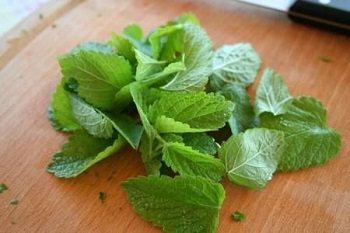

Menthol has an antihypertensive effect. Great care and strict adherence to dosage is needed for those with consistently low blood pressure.
Naturally, mint teas are contraindicated for allergies or individual intolerance to this product.
Do not use drugs with menthol to treat children under 3 years of age due to the danger of respiratory paralysis.
If a woman likes mint so much that she does not want to give it up even during pregnancy, then she should definitely consult a doctor about this, since contraindications are possible. Menthol causes the uterus to contract, which can lead to miscarriage.
Patients with varicose veins are also better off refusing mint drinks.
What is the harm and benefit of tea made from cherry leaves: you will find out the recipe for making a healing drink by reading our useful material!
Read about the beneficial properties of sea buckthorn berries and how to properly use and store the fruits of a medicinal plant in our review.
And how is red viburnum useful for health? Read all about the beneficial qualities of this berry here:.
When to harvest and how to dry mint


The plant does not require careful care and special growing conditions, so many housewives grow grass in a flower pot. In this case, it is necessary to cut off the leaves during the ripening period several times a month.
Home-grown mint must be properly dried. There are several proven ways:
- Using an oven or dehydrator. The method is effective, but the product loses most of its useful properties.
- Hanging herbal bunches in a well-ventilated dark place.
- Drying washed stems and leaves on a natural fabric, away from sunlight.
What is this plant
Mint is a perennial herb from the Lamiaceae family. It is grown as a spice for the food industry and for medicinal use. The culture is unpretentious, it grows in almost any summer cottage. More than 20 species have been found in nature. The most famous representatives of this aromatic herb are peppermint, wild, home, garden and water mint.
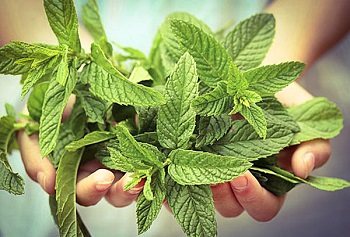

Varieties of this culture have a flexible stem, small flowers collected in inflorescences, elongated, lanceolate, saw-toothed leaves.
The bright green leaves and stem, depending on the type of plant, are smooth or hairy-bristly.
Shoots grow from 20 cm to 1 m in height, bloom from late June to early September. Inflorescences look like spikelets with reddish or white-pink flowers.
The plant is so undemanding that it grows on any soil in the countries of the Northern Hemisphere with a prevailing temperate climate. He does not need special care or mineral fertilizers, but moderate humidity of air and soil is necessary for full growth.
It grows well both on sunny lawns and in shaded areas.Favorite growing places of mint are around lakes, in rare forests, in meadows. It is easy to grow it yourself: you can plant one shoot in your summer cottage or in the garden, and then it quickly grows by actively dividing creeping roots. Propagated by cuttings, rooting leaves, seeds.
Homemade mint can feel great in a pot on a windowsill. But she needs as much sunlight as possible.
You can collect leaves as early as June, but the highest concentration of essential oils in the stems and leaves is observed at the end of flowering.
Herb with a "chill": studying the benefits of mint
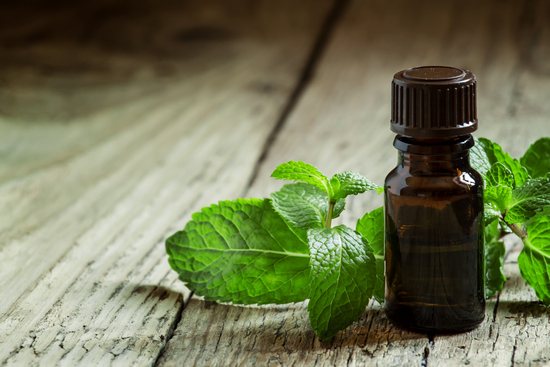

The family of such plants has up to 20 species (this also includes lemon balm). But the most popular is peppermint. Its benefits and harms are due to the characteristics of the chemical composition.
One of the most important components of peppermint is essential oil. Its amount in leaves reaches 2.5%, and in flowers it is even higher - up to 6%. Mint contains menthol, which gives it a peculiar fresh aroma and cooling taste.
In addition to ascorbic acid, the content of which in mint is at least 0.01%, it contains many other vitamins - retinol, PP, E, six representatives of group B. It is rich in valuable macronutrients - from phosphorus, sodium, magnesium to calcium and potassium.
Microelements are also widely represented in mint, and the main ones are iron, zinc, manganese, and copper. Its leaves, stems, inflorescences contain a lot of dietary fiber, phytoncides, saturated fatty acids.
Such a variety of medicinal substances allows mint to have a complex effect on the body. It has anti-inflammatory, antiseptic, relaxing, anesthetic, antimicrobial, expectorant, antispasmodic, moderate laxative effects.
Treated Mint Abilities:
- accelerates recovery from colds;
- has a diuretic effect;
- stabilizes the work of the cardiovascular system;
- inhibits aging, as it is a powerful natural antioxidant;
- relieves foci of inflammation;
- positively affects digestion: suppresses the activity of Helicobacter (bacteria that provokes ulcers), Staphylococcus aureus, Escherichia coli;
- eliminates diarrhea;
- strengthens the nerves;
- tones up in the morning, soothes in the evening;
- relieves cramps;
- reduces the gag reflex;
- heals the throat;
- activates intestinal motility, removes putrefactive processes in the intestines;
- eliminates bloating;
- demonstrates antimicrobial activity;
- improves appetite;
- produces a choleretic effect;
- relieves migraine;
- relieves insomnia;
- helps to eliminate itching;
- has a low calorie content: only 65-75 Kcal is contained in 100 g, so mint can serve as a component of a diet for weight loss;
- reduces pain in rheumatism, promotes resorption of hematomas (in the form of compresses);
- tidies up the metabolism.
For outdoor use
Mint decoctions have been found to be used as a variety of means for wiping the skin, making lotions in order to solve a number of cosmetic problems.
For acne
Mint leaves (dry or fresh) are laid out in an enamel ladle, filled with cool water - 100 ml. Put on fire under the lid. When the liquid boils, the heat is reduced to a minimum and the mass is boiled for 10 minutes.
After removing the dishes from the stove, keep them covered for 20 minutes. The drained liquid is used as a tonic, wiping the acne areas twice a day.
You can make lotions, for which a cotton soft napkin is impregnated with a product warmed to 45 degrees, and left on problem areas for 30 minutes.
From chin hair
Since peppermint actively reduces the level of androgens, that is, male hormones that provoke hair growth on the chin, it is useful to take a decoction from this plant in order to eliminate this problem.
Pour a teaspoon of chopped dry mint herb into a glass of boiled water. Let it boil for no longer than a minute and leave for 10 minutes. Then the broth must be filtered.
Take a cup in the morning and evening. To get a lasting result, it is recommended to carry out this action for 6 months. Then take a two-month break and, if necessary, repeat the reception.
For face
Mint broth is used to rejuvenate, moisturize, tone, cleanse the epidermis. This product improves complexion, makes it more elastic and fresh.
Put fresh (you can take dry) mint leaves in an enamel ladle - 12 g. Steamed with half a glass of boiling water, cook under a lid at minimum heat for 10 minutes. The filtered cool liquid is used in the morning and in the evening as a tonic, wiping the cleansed face. Helps get rid of clogged comedones.
An article for you:
Flaxseed decoction: indications for use, health benefits and harms
In order to moisturize the dried skin for 7 minutes, boil 2 tbsp. l. chopped mint herb in 500 ml of water. After filtration with liquid, you should wash your face every morning.
To refresh and rejuvenate aging skin, pour 2 cups of boiling water into an enamel bowl. Put mint leaves - 2 tbsp. l. Boil on low heat for 20 minutes. Insist 10 minutes under a towel.
Then add vodka - 2 tbsp. l., fresh fresh lemon and red rowan berry puree - 1 tbsp. l. Leave in glassware for two days. Wipe your face with a strained agent in the morning and in the evening.
For hair
Mint broth is used in hair care. When using it, the structure of the curls is restored, the roots are strengthened, the natural silky shine of the strands returns. Dandruff is reduced, itching and excess sebum are eliminated.
For cooking, pour 500 ml of boiled water into a saucepan, put chopped mint into it - 2 tbsp. l. Boil with very slow heating for 10 minutes. The filtered liquid is used for the final rinse of the washed hair.
Lice
You will need to squeeze 200 ml of fresh pomegranate juice. Pour it into an enamel bowl, add mint leaves - 2 tbsp. l. With slight heating, boil for 8 minutes.
When the product cools down, apply it to the hair in the evening, actively rubbing it into the skin. Wrap up the head with a film and a warm scarf. Keep until washed off overnight for about 8 hours.
Does male mint tea spoil the "summer weather"? Why is mint called "female"?
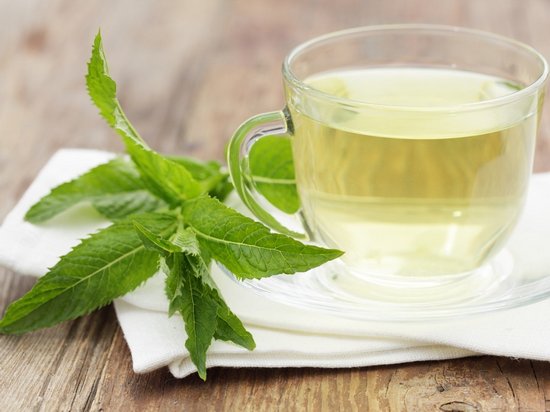

Mint is a plant, the benefits and harms of which are not the same for representatives of different sexes. She provides women with great support in the matter of health and beauty.
Qualities of mint that are useful for girls and women:
- heals milk stagnation in a nursing woman: to get rid of lumps in the breast, you should apply mint leaves gruel to the "bumps";
- helps to relieve painful and heavy periods;
- relieves symptoms of toxicosis during pregnancy;
- reduces the manifestations of menopause;
- can serve as an adjunct for the treatment of inflammation "like a woman";
- improves the condition of dry colored hair;
- in the form of tonic and masks, it benefits "tired" skin - refreshes, smoothes fine wrinkles, and also removes greasy shine, tightens pores;
- slows down the growth of hair in "unnecessary" places (antennae, vegetation in the armpit).
Important! The expectant mother is allowed to drink mint only after consulting a doctor!
Although peppermint infusion is considered an effective hangover cure, it is best for men not to use it frequently. Refreshing tea with regular use negatively affects potency and excitability, as it reduces testosterone levels.
How does mint affect the potency of men?
So, the mint was "compromised" not entirely undeservedly.As a result, many people got the feeling that it should be completely excluded from their diet, so as not to damage sexual activity. So, among the search queries, the question "why shouldn't men drink tea with mint" is even leading.
The funny thing is that in fact, mint, rather, can improve potency than harm it. The fact is that it is good at helping to reduce stress and anxiety - the real enemies of healthy libido and erection.
The main thing, as in everything, is not to forget about the measure, so drinking ten cups of tea with mint every day is still not worth it.
No mint! Who should give it up?
How not to love this herb? Pleasant taste and fresh aroma - health benefits! It's a pity, mint is not good for everyone, and it has plenty of contraindications.
Restrictions and prohibitions on the use of mint:
- individual intolerance: mint can cause severe allergies;
- hypotension: it lowers blood pressure;
- low acidity of gastric juice;
- varicose veins;
- lactation: the formation of breast milk will decrease;
- infertility: if a woman has problems with conception, regular consumption of mint will only aggravate the situation - the egg will lose the ability to fertilize;
- children under 5 years of age: this plant contains many active biocomponents, which can create too much stress on the baby's body;
- pregnancy with complications, as well as if a woman is expecting a male child.
Mint for men - friend or foe?


Shot from the series "Friends"
If willow tea is called “male herb”, then mint, on the contrary, is traditionally considered “female”. But does this mean that those who care about their masculinity should fear it like fire?
And why do some even think that men shouldn't have mint? Let's sort things out in order and dot the "and".
Secrets of brewing menthol tea
The standard method for brewing mint tea is to add 1 tbsp of water to 250 ml of boiling water. l. dry crushed mint. Tea is infused for 15 minutes. Mint water will be unusually tasty - 1-2 bunches of fresh grass need to be poured with 500 ml of pure water. Or you can just add 1 tsp. mint in black tea.
Other recipes are suitable for preparing a medicinal drink. To get an infusion that will help relieve pain in the heart, you should take 2 tsp. chopped leaves, brew 1 tbsp. freshly boiled water. Leave on for 20 minutes. Strain, drink 150 ml 1-3 r. in a day.
To make a decoction, you need 15 g of dried herb. It is poured with 1 tbsp. water. Boil for 10 minutes. Insist for half an hour. Take 1 tbsp. l. from 3 to 4 p. per day, preceding a meal.
Peppermint decoction


Making mint tea at home is easy using proven disease-specific techniques.
For insomnia
Pour 500 ml of water into an enamel pan and add dried mint, 1 tbsp. l. With slight heating, boil for 10 minutes. The cooled liquid is filtered. It is recommended to take 100 ml before breakfast, lunch, dinner. If desired, slightly sweeten the drink with honey. Regular intake helps to additionally cope with overexcitation, neuroses.
From pressure
Among the most effective means of reducing pressure, a decoction of washed raisins stands out - 100 g and 1/2 tbsp. l. chopped mint leaves. This mixture is placed in a saucepan with a glass of boiled water and cooked over low heat for five minutes. Keep under the lid for an hour, and then filtered. It is recommended to take 50 ml on an empty stomach in the morning and in the evening.
From nausea
With its antispasmodic and soothing effect, mint effectively relieves nausea. You will need dried grass, which is crushed, take a teaspoon and pour into a saucepan with a glass of hot. Boil for one minute, remove from heat and leave under the lid. The cooled strained agent is taken before breakfast, lunch, dinner, 50 ml each.
For the immune system
Peppermint contains vitamin A, one of the benefits of which is to stimulate the production and improve the functioning of white blood cells. One recent study found that consuming peppermint helped inhibit the activity of acyclovir-resistant herpes simplex virus type 1.
Consuming mint leaves prevents cell and DNA damage associated with radiation exposure.


Effective anti-allergen
Many women suffer from rhinitis every year. In 2001, mint leaf extracts were found to inhibit the release of the chemical histamine, which is known to aggravate the symptoms of allergic rhinitis and other seasonal allergies. Peppermint also contains an anti-inflammatory agent called rosmarinic acid, which is effective in relieving seasonal allergy symptoms.
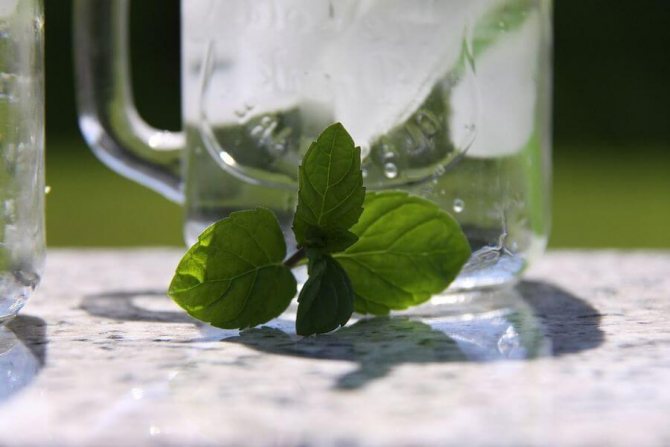

With anemia
As we have seen, peppermint provides the body with sufficient amounts of essential nutrients, including iron and folate. Both are essential for the formation of healthy red blood cells, and an excess of either leads to anemia.
A half-cup serving of mint leaves contains 30 percent of the recommended daily intake of iron for women, as well as 12 percent of our daily folate needs. This is another good reason for pregnant women to include mint in their diet, as anemia is extremely common among expectant mothers, which has negative consequences for both parents and children.
Helps Fight Depression and Fatigue
For depression, anxiety or fatigue, some doctors advise starting the use of peppermint or its derivatives, both internally or topically, and inhaling the steam - all of these methods can provide a quick and pleasant burst of energy. A good result will be the application of a drop or two of peppermint oil on the pillow before bed. After a long day at work, a good foot massage or even a simple scrub and brush can do wonders for lifting your spirits. By adding a few drops of peppermint oil to a foot scrub or massage cream, even the most severe fatigue can be relieved.
Improves the functioning of the nervous system
Adding copper to your diet promotes the body's production of phospholipids, certain fats essential for a healthy nervous system, and improves overall brain cell communication. Mint leaves are a good source of copper. A half cup serving provides 12 percent of women's daily copper needs.
Strengthens bones
Peppermint is also a rich source of manganese, which helps your body synthesize certain proteins needed for wound healing and also strengthens bones. Half a cup serving of mint leaves provides 28% of the daily manganese requirement for women.
Collection and storage rules


The herb is harvested during the active flowering season, when the highest concentration of tannins, flavonoids, is reached. In summer, in June-July, the grass is harvested both as separate leaves and by collecting stems with flowers. You should first make sure that the culture does not grow along the roads, there is no dew on the leaves and you do not need to take the grass immediately after the rain.
Ginger: properties, methods of application and contraindications for prostatitis
Drying is a long process, and the grass is not washed before harvesting! Hay should be immediately protected from direct sunlight so that the heat does not release essential oils - one of the most valuable components of the culture. To dry the hay, you need to tie the plants in loose bunches and hang them in the shade in a well-ventilated room. If only the leaves are collected, they are laid on a canvas or paper, from time to time they are turned up so that the raw material does not burst.
Advice! Drying the workpiece in the oven is not recommended.However, if you need to quickly apply dry collection, drying is carried out with the door open, the temperature is no more than 35 C, the drying time is until the raw material begins to crumble in the fingers.
It is best to store the workpiece in a jar with a tightly lapped lid. Raw materials need protection not only from dampness, but also from sunlight, so linen, cellophane bags are not suitable. The shelf life of properly dried raw materials is 24 months.
Mint in cosmetology
This plant has proven itself well in cosmetology. A decoction of mint for the face helps to even out skin tone, improve its appearance, tighten pores, and prevent premature aging.
- To cleanse the skin and get rid of the oily sheen, take a few tablespoons of dried mint and pour boiling water over it for 30-40 minutes. Strain, apply the cooled broth to a cotton pad and wipe the skin.
- Herbal warm compresses give a good effect on skin tone. To prepare them, you need fresh mint leaves. They must be thoroughly washed, filled with hot water and wait 10-15 minutes. Put the steamed leaves on the face, cover them with a napkin soaked in mint solution. Cosmetologists recommend this procedure 1-2 times a week. The result is visible after the first application.
You may be interested in: Liver tea for liver health and recovery
A decoction of mint for hair is very useful. Mint perfectly cleanses the hair, strengthens the roots, restores the structure and gives the hair shine. Also, mint is considered one of the best remedies for hair loss, due to the strengthening effect of this plant on hair follicles.
Mint decoction is used to rinse hair after shampooing. For the preparation of the broth, both leaves and mint flowers can be used. Two tablespoons of herbs are poured with 1-2 liters of boiling water. The broth should simmer for 10 minutes. Next, you need to strain it. To achieve the best effect, it is recommended to use the mint broth as often as you wash your hair.
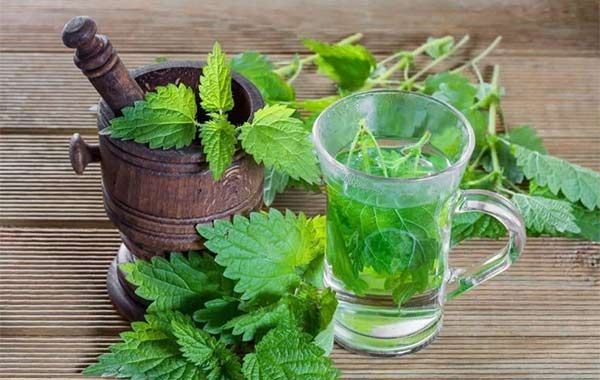

Testimonials
Anna:
We grow this unpretentious plant in our country house. In addition to eating, we drink aromatic, delicious mint tea. I give infusion to children at elevated temperatures, because mint promotes sweating, relieves fever. I take it myself for nausea, headache, fatigue. Mint leaves are an excellent decoration for dishes.
Svetlana:
I grow fragrant grass on the balcony. Miracle mint improves sleep, soothes, improves appetite. I freeze the broth of mint in a special container using refreshing ice cubes for morning wash. The face becomes rosy and toned. To improve the condition of the hair, I rinse them with herbal decoctions (with mint, chamomile, nettle). The result is shiny, manageable and healthy hair.
Alyona:
I like mint tea - 100% natural, inexpensive, with a magical aroma. I drink in the evening, with honey, lemon, jam or just like that. I brew in a thermo mug to enhance the color and aroma. After such a drink, unnecessary anxieties, restless thoughts go away, calming, pacification appears. I also like to take other herbs: chamomile, linden, oregano, rose hips.
The healing properties of mint infusions
- Alignment of the heart rhythm, benefits for blood vessels, general sedative effect;
- Relief of migraine pain, pain during the menstrual period. A large amount of the herb is found in many drops for toothache;
- Help with gastrointestinal diseases;
- Calming effect on the nervous system;
- Treatment of colds and viral diseases;
- A good diuretic, removes puffiness, relieves excess moisture.
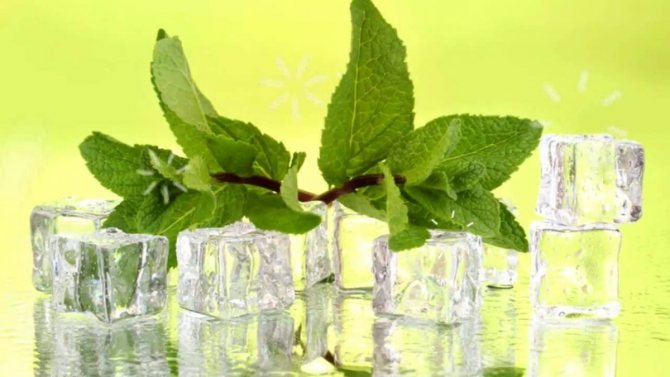

Natural mint tea is a drink with a long history that saturates, refreshes, heals, has a fragrant aroma
Female aphrodisiac
Peppermint has been known as an aphrodisiac since the days of the ancient Greeks, when the physician Galen proved its ability to induce desire in women.While there is no medical evidence for its aphrodisiac properties, it is widely believed that peppermint is a powerful stimulant for the mind and body.
The key to mint's reputation as an aphrodisiac lies in its powerful stimulating properties:
- The main active ingredient in peppermint is menthol - up to 70%, which is a type of alcohol and causes a cooling sensation. The other main component is an ester known as methyl acetate, which is responsible for the characteristic smell of peppermint. Other herbal ingredients include menthone, limonene, pulegon, cineole, and azulene. The cumulative effect of all these compounds is to increase concentration and alertness, making the mind more aware of the factors of sexual arousal. The scent also stimulates the physical sensations and, when applied to the skin, produces a cooling and exhilarating sensation that makes erogenous zones in women more receptive to pleasure.
- Another way that peppermint acts to induce desire is through its characteristic aroma. Mint has a powerful fresh camphor scent that energizes the senses of smell and taste and opens the mind to enjoyment. According to traditional sources, inhaling the scent of mint can activate the imagination and induce erotic dreams in women. And since it is the brain that controls all sex hormones, anything that stimulates, to some extent, inevitably arouses sexual desire in women and leads to intense orgasms.
- Despite the initial cooling sensation when consumed, peppermint actually has a warming effect on the blood - dilates blood vessels and promotes the supply of oxygen-rich blood to various organs, including the vagina, in women. Higher oxygen and blood levels facilitate arousal and lead to intense orgasms. The same effect of peppermint has also been used to relax muscles, so it acts as a powerful anti-spasm.
- In addition, mint contains a variety of nutrients that are essential for women's health. The two most important vitamins present in the plant are vitamins A and C, both of which are well-known antioxidants and are critical for strengthening immunity as well as maintaining physical vitality. In addition, peppermint contains components such as manganese, iron, calcium, folate, potassium, tryptophan, magnesium, omega-3 fatty acids, riboflavin, and copper, which are beneficial for a healthy sex life.
For the oral cavity
Peppermint is a natural antimicrobial and breath freshener, promotes oral hygiene and prevents the growth of harmful bacteria in the mouth (which improves breathing!) While cleansing the tongue and whitening teeth. In fact, this is the reason why people in the Middle Ages rubbed mint leaves on their gums and teeth! In modern times and for similar reasons, mint is a widespread element in toothpastes, toothpicks, mouthwashes, and the like. The concentrated peppermint oil extract outperforms the chemical chlorhexidine mouthwash in killing bacteria that cause bad breath, along with the biofilm controlled by streptococci.
What is it and how is it different from infusion?
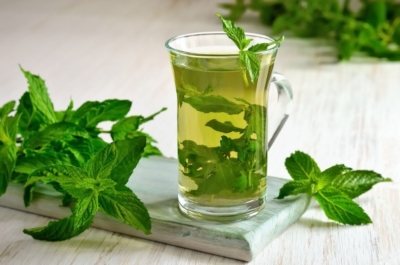

The broth is a healthy drink that contains many vitamins and useful microelements, and also helps in the fight against many diseases. Let's find out the difference between decoction and infusion.
There are two types of infusion: hot and cold... The first is prepared in a thermos, and the second in a water bath. But neither in the first nor in the second case, the water should not reach the boiling point. The broth differs from the infusion in that it is necessarily boiled during the preparation process.
Attention!
Broths, as well as infusions, can be cooked in a water bath, but for a longer time.
We also have a detailed article about mint tea, its medicinal properties and contraindications.
How to use lemon balm essential oil
The ether of this plant is very beneficial for health. It can be purchased at the pharmacy. It is important to buy the most real essential oil. Pay attention to the label.
There should be such an inscription - 100% natural (if in English, then 100% essential). Other inscriptions speak of a fake. A quality product always has a date of manufacture on the packaging and quality certificates on the instructions.
How to use essential oil. Most useful in inhalation and in aroma lamps. Inhalations treat the respiratory tract for infectious diseases, bronchitis, sore throat, flu, ARVI. The smell that will dissolve the aroma lamp is able to disinfect the living room and bedroom. It is enough to drop three drops, and most of the viruses will be destroyed.
The cheerful scent of lemon balm will relieve depression, improve brain activity, ease fits of anger, drive away bad thoughts.
If you have hair problems, then 7-10 drops of lemon balm essential oil in a bottle of shampoo or balm will be good for your hair. The tool will help get rid of seborrhea, alopecia, eliminate excessive greasiness of the scalp, and stimulate hair growth.
One drop in the balm with which you will lubricate your lips will help to restore brightness and velvety to your lips. Foot massage with lemon balm ether will help restore good sleep, eliminate depression.
Mint for cancer
Peppermint contains antioxidants, and science has repeatedly shown a link between a diet rich in fresh fruits and vegetables, which is high in antioxidants such as vitamin C, and a reduced likelihood of developing various types of cancer. And every woman knows that it is possible to keep youthfulness only with their help.
Peppermint contains a phytonutrient called monoterpene, which studies have shown can stop the growth of pancreatic, liver and breast cancers in women. In addition, peppermint contains a compound known as perillyl alcohol, which may stop cancer from developing and spreading.
Precautions
Mint for the stronger sex, of course, is a useful medicinal plant. The only point why men should not mint is the presence of an allergy to the plant or contraindications. However, for safety reasons, when using mint for medicinal purposes, and not just as a pleasant drink, it is necessary to consult a doctor.
Contraindications for consuming mint include:
- low blood pressure;
- increased acidity of the stomach;
- heartburn;
- phlebeurysm;
- individual intolerance.
Mint decoction for the cat


In order to correct the behavior of cats, the so-called catnip or catnip is used. The action of this plant depends on the temperament of the animal.
If the cat is aggressive, then under the influence of mint aromas, he becomes calm and docile. Conversely, for a sluggish animal, this plant becomes a catalyst for more active playful behavior.
To prepare the broth, boil dried raw materials - 2 tsp. in a liter of water no longer than 5 minutes. When the liquid has cooled, it is filtered.
It is not recommended to give it to pets in its pure form. To convey the aroma, the agent is poured into a spray bottle and sprayed, for example, on a scratching post, attracting an animal to it.
You can soak a soft toy with broth, and then dry it thoroughly. Even a phlegmatic cat will play with pleasure with such an object. Mint aromas are used to train the cat to the litter, where he should rest.
It should be borne in mind that the prohibition on catnip is the pregnancy of females. You can't often attract cats with an overly aggressive character with such a scent.
Useful Tips
- Tea should be consumed immediately, due to the fact that essential oils, which bring the greatest benefit, quickly evaporate after brewing. Thus, the tea becomes less useful, and the taste is no longer so pleasant.
- When brewing, mint can be mixed with green, black tea, as well as with chamomile. The resulting drink can be served with honey and lemon.
- In summer, mint tea will quench your thirst perfectly. To do this, put a few ice cubes in a freshly brewed drink.
Due to the fact that mint can be stored in a dried, frozen form, you can enjoy freshly brewed aromatic tea all year round.
Healing tincture on lemon balm
Vodka tincture will be useful for the treatment of CVS diseases, hypertension, headaches, insomnia, nervous disorders, memory problems, gastrointestinal diseases, "female" diseases, increased irritability.
The tincture should be taken in 15 drops, mixing it with a small amount of water, three times a day, 15 minutes before meals. The term of treatment is 30 days, then take a break for 2 weeks and repeat the treatment.
How to cook: chopped lemon balm leaves - 50 g, pour 250 ml of vodka, remove to the basement. Let it brew for 3 weeks. Then strain the tincture and take it orally.
Attention! The tincture is a strong medicine, not an alcoholic beverage, so it must be taken in drops.
But this drink, using moonshine, can be served for any holidays: take 30 g of dry raw materials, an incomplete glass of granulated sugar, a glass of boiling water and 1 liter of moonshine.
How to cook:
- Pour the raw materials with boiling water, let it brew for 30 minutes.
- Add sugar, stir until completely dissolved.
- Pour the mixture with moonshine, let it brew for a week in a cool place.
Pleasant soft taste will please both you and your guests.

